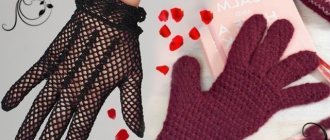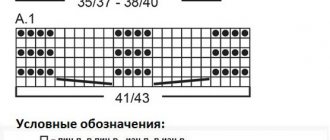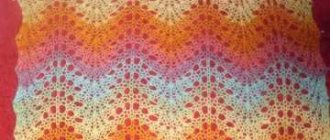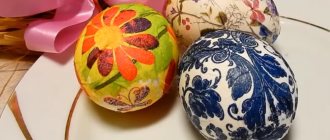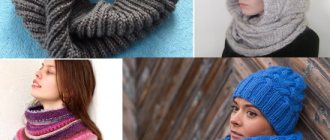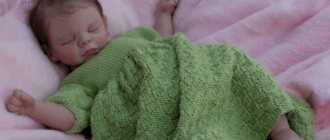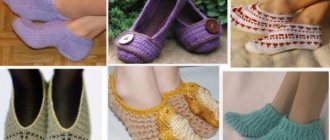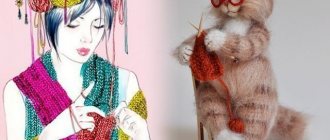Stylish patterns with knitted knobs are extremely popular among needlewomen; they allow you to give the product additional volume and originality. The cones can be placed anywhere in the product, at the request of the craftswoman.
Can you knit? Publish your work on knitka.ru
Patterns with cones: varieties, types
The bulges themselves, i.e. cones can be knitted with knitting needles of different sizes - small, medium, large - depending on the knitting technique. Three, five, seven or more loops are knitted from one loop, which is why the size of the bump is directly dependent.
There are the following types of knitted patterns with cones:
- on the reverse background;
- in stocking stitch;
- in the form of separate inclusions on the finishing strip, etc.
This pattern, containing continuous bumps, can be used to knit the entire product. Cones are often knitted to represent berries in plant motifs. Also, rows of bulges knitted with knitting needles can form diamonds, which looks great not only on children's, but also on adult clothing models.
Where are patterns with knobs on knitting needles used?
Using knitting needles, the following items are knitted with patterns with cones:
- hats, scarves, snoods;
- cardigans, jackets, sweaters, vests;
- jumpers, pullovers, sweaters;
- dresses, tunics, stoles;
- shirtfronts, etc.
Patterns with knitted bumps are also good as trims in combination with flat, calm knits. Even booties and socks are decorated with original bumps on the knitting needles in the form of knobs.
What threads are used
In order for the pattern with knobs, knitted with knitting needles, to be as embossed as possible, it is recommended to take yarn of medium thickness or even thick, and the composition of the threads does not matter much. The following materials are suitable:
- wool with additives of synthetic threads in various proportions;
- acrylic;
- polyamide;
- knitting yarn;
- natural cotton threads, etc.
It is quite acceptable to knit with a knitting pattern using thin threads, in which case the bumps will be smaller. Bumps made from fine yarn in combination with openwork knitting are also popular. Cones of yarn of different thicknesses are knitted on knitting needles: these are beautiful patterns with a twist. There are also patterns in which the cones are crocheted.
Knitting "Cocoon" pattern
We cast on the initial stitches, their number should be a multiple of 8 + 1 symmetry stitches + 2 cr. P.
- 1 rub.: cr. n., *1 l. p., 5 i. p., 1 l. p., 1 i. p.*, from * to *, complete 1 l. p., cr. P.
- 2 rubles: cr. n., *1 i. p., 1 l. p., 1 i. p., 5 l. n.*, from * to *, 1 and. p., cr. P.
- 3 rubles: cr. n., *1 l. p., 5 i. p., 1 l. p., 1 i. n.*, from * to 8, 1 l. p., cr. P.
- 4 rubles: cr. p., *add a p. from the broach, (1 l. p., 1 i. p., 1 l. p.) to the next. p., add p. from the broach, 1 and. p., 5 p. vm. purl*, from 8 to *, complete 1 and. p., cr. P.
- 5 rubles: cr. n., *1 l. p., 1 i. p., 1 l. p., 5 i. p.*, from * to *, complete 1 l. p., cr. P.
- 6 rubles: cr. n., *1 i. p., 5 l. p., 1 i. p., 1 l. n.*, from * to *, 1 and. p., cr. P.
- 7 rubles: cr. n., *1 l. p., 1 i. p., 1 l. p., 5 i. p.*, from * to *, 1 l. p., cr. P.
- 8 rubles: cr. n., *1 i. p., 5 l. p., 1 i. p., 1 l. n.*, from * to *, 1 and. p., cr. P.
- 9 rubles: cr. n., *1 l. p., 1 i. p., 1 l. p., 5 i. p.*, from * to *, 1 l. p., cr. P.
- 10 rubles: cr. n., *1 i. p., 5 p. vm. i., 1 i. p., add a p. from the broach, (1 l.p., 1 i.p., 1 l.p.) to the next. p., add p. from the broach, 1 and. p.*, from * to *.
- 11 r.: cr. n., *1 l. p., 5 i. p., 1 l. p., 1 i. p.*, from 8 to *, finish 1 l. p., cr. P.
- 12 rubles: cr. n., *1 i. p., 1 l. p., 1 i. p., 5 l. p.*, from 8 to *, 1 and. p., cr. P.
Descriptions of beautiful patterns with cones
Relief pattern with knitted knobs
Excellent relief pattern with small bumps. ⠀ For the sample, dial an even number of loops. The pattern is repeated every 4 rows. Small “bumps” are arranged in a checkerboard pattern. ⠀ Description of the pattern: Row 1: chrome, * k1, purl 1*, repeat until last stitch, chrome.. 2
Read more…
Japanese pattern with cones, description and video tutorial
Japanese patterns attract many needlewomen because they look elegant and interesting. We knit the motif with 16 stitches. Repeat from rows 1 to 12. The diagram shows the front (odd) rows. Knit purl (even) rows according to the pattern of the fabric (i.e.
Read more…
Aran pattern with cones from Svetlana Loseva
This relief pattern looks very impressive. It can be used in both adult and children's products. I knitted a cropped jumper with this pattern. Motif width = 29 p. Repeat in height = 16 p. Pattern is made on
Read more…
Knitted cone pattern, video tutorial
I recorded a master class on knitting the “Pine cones” pattern at the request of spectators. In it I show in some detail the creation of a cone pattern with knitting needles. You can knit it as a pattern or add it to other patterns as a highlight. Knitting pattern
Read more…
Knitting pattern BONES, description
An original and beautiful knitting pattern, which is perfect for both knitting a whole product and finishing individual elements. Knitting “cones” is not difficult; even a beginner can handle them. To knit a pattern on knitting needles, cast on the number of loops
Read more…
Relief pattern with Boucle knitting needles, small bumps
A spectacular and beautiful relief pattern that can be used to create a wide variety of things: scarves, hats, sweaters, sweaters, blankets. The main pattern is formed with the help of “bumps” on the wrong side of the product, and the front stitch is knitted on the front side. For knitting pattern
Read more…
The Malinka pattern also refers to a variation of cones, see our selection with Malinka patterns
How to knit the Raspberry pattern (large cones)
On the Internet you can find many beautiful and interesting patterns, one of them is the Malinka pattern. It is also called the Bubbles, Cones, etc. pattern. But it seems to us that the name Malinka most clearly reflects its essence. _postrf Popularity
Read more…
Pattern "Malinka"
We cast on the initial loops, their number should be a multiple of 6 + 5 stitches for symmetry + 2 cr. p (edge loop).
- 1 rub.: cr. p., *2 i. p., (1 l.p., n., 1 l.p., n., 1 l.p.) in the next. p., 2 i. p., 1 l. p. for s/s (back wall)*, from * to * to the extreme 6 p., 2 and. p., (1 l.p., n., 1 l.p., n., 1 l.p.) in the next. p., 2 i. p., cr. P.
- 2 rubles: cr. p., *9 l. p., 1 i. p.*, from * to * until the last rapport, we finish kr. p. instead of 1 i. P.
- 3 rubles: cr. p., *9 i. p., 1 l. p.*, from * to * until the last rapport, we finish kr. p. instead of 1 i. P.
- 4 rubles: cr. p., *9 l. p., 1 i. p.*, from * to * until the last rapport, we finish kr. p. instead of 1 i. P.
- 5 rubles: cr. p., *9 i. p., 1 l. p.*, from * to * until the last rapport, we complete the cr. p. instead of 1 i. P.
- 6 rubles: cr. p., *2 l. p., 5 p. vm. l., 2 l. p., 1 i. p.*, from * to * to extreme rapport, complete cr. p. instead of 1 i. P.
- 7 rubles: cr. p., 2 i. n., *1 l. p. for salary, 2 i. p., (1 l.p., n., 1 l.p., n., 1 l.p.) in the next. p., 2 i. p.*, from * to * to the last 4 p., 1 l. p. for salary, 2 i. p., cr. P.
- 8 rubles: cr. p., 2 l. n., *1 i. p., 9 l. p.*, from * to * to 4 p., 1 i. p., 2 l. p., cr. P.
- 9 rubles: cr. p., 2 i. n., *1 l. p., 9 i. p.*, from * to * to 4 p., 1 . p., 2 i. p., cr. P.
- 10 rubles: cr. p., 2 l. n., *1 i. p., 9 l. p.*, from 8 to * to 4 p., 1 i. p., 2 l. p., cr. P.
- 11 r.: cr. p., 2 i. n., *1 l. p., 9 i. p.*, from * to * to 4 p., 1 l. p., 2 i. p., cr. P.
- 12 rubles: cr. p., 2 l. n., *1 i. p., 2 l. p., 5 p. vm. l., 2 l. p.*, from * to * to 4 p., 1 i. p., 2 l. p., cr. P.
EXAMPLES of products related to the cone pattern
Openwork jacket with a “bump” pattern
Sizes: 38/40 (P1), 42/44 (P2J, 46/48 (RZ). 50/52 (P4). To knit a jacket you will need: Bouton d'Or yarn: 10/11/12/13 skeins Mango (50% cotton, 50% viscose, 110 m/50 g} blue-green (1091); knitting needles No. 3 and No. 3.5; 8 buttons. Addition in the fabric: raise the horizontal thread
Read more…
Set Pink cones - hat and snood
The “Pink Bubbles” set is made of Yarnart Denim yarn. A hat and a snood with cones for a girl are knitted and crocheted. Products made from this yarn are soft, not scratchy at all, and with proper care will last for more than one season,
Read more…
Women's hat with a cone pattern
Hat with a pattern with cones. Yarn: ALIZE LANA midi (100g/170m; 25% wool, 75% acrylic) Color number: 161 Number of skeins: 2. Yarn consumption 130g. Knitting needles: No. 3.5 (circular). Head circumference: 56 cm. Cap height: 25 cm. Knitting techniques used: 1x1 elastic band, relief pattern with cones. A cap
Read more…
Spring hat knitted with a cone pattern
Any yarn with a yardage of 200-250 m per 100 g is suitable for a hat. Knitting needles No. 3. Size for a girl 3-4 years old and head volume 50-52 cm. Description of the hat for a girl Cast on 100 loops using any method. Rib knit 3 knits and 2 purls 13
Read more…
Women's jumper with a pattern of openwork flowers and cones
A beautiful jumper with a pattern of “openwork flowers” and “cones”. Yarn: “Pekhorka” merino, classic series, 100g/200m Composition: 50% merino wool, 50% acrylic. Yarn consumption = 500 g. Color: pink. Number of skeins: 5. Knitting needles: No. 4 (straight and circular). Jumper size: 44. Used
Read more…
Beautiful knitted scarf with cones from Irina
We cast on 32 loops, plus one edge at the edges, knit with a 30 cm “Bumps” pattern. Then we double the number of loops, knitting new loops from broaches and knit 70-80 cm in stockinette stitch, i.e. front rows, all the loops are knitted, purlwise rows, purl all stitches.
In the last row, add one more loop after the first edge and before the last edge = 66 loops. Next we knit with the “Bumps” pattern 15 cm. Close the loops. Now you need to fold the long part with the pattern in half and sew the edge to the scarf, thus creating a loop. This is a diagram of the bump pattern. The number of loops should be divided by 8 plus edge loops.
How to knit cones, see the link
Knitting a stole with knitting needles with a cone pattern
A very beautiful unusual white stole with bumps. The description and diagram are in English, but if you wish, you can understand the symbols.
- Stole size: 128*43 cm.
- For knitting you will need 250 g. DROPS Baby Merino yarn (100% wool, 175m/50g) and 3mm knitting needles.
Knitting pattern for a stole with a cone pattern
Simple knitted bumps on stockinette stitch
We cast on the initial loops, their number should be a multiple of 4 + 1.
- 1 p: 1 i. p., *3 l. p., 1 i. p.*, from * to *.
- 2 rubles: 1 l. n., *3 i. p., 1 l. p.*, from * to *.
- 3-4 pp.: like 1-2 pp.
- 5 rubles: 1 i. p., *from 1 p. we knit 1 p. for the front, 1 p. for the back, 1 p. for the front, 1 p. for the back and 1 p. for the front wall, then 1 l. p., 1 i. p.*, from * to *.
- 6 rubles: 1 l. n., *1 i. p., 5 i. p.vm., 1 i. p., 1 l. p.*, from * to *.
Video lesson
A video master class from a professional knitter will help beginners learn how to knit cones faster. As you can see from the video, such a pattern can be done quickly and without intense calculations.
Crochet cone pattern - video:
Share with your friends!
- 57
- 5
- 111
- 173
Shared
Subscribe to our Yandex.Zen channel or Yandex.Messenger
Three loops
Before making such a decoration, you should determine the location of the future pattern and the loop from which the element will be made. Having tied to a certain place, you should follow the following instructions:
- On the wrong side of the stitch (front side), you should knit three stitches from one stitch. Usually they are alternated - loops are knitted alternately through the front and back walls of the fabric or yarn overs are made between them.
- Turn the product and knit a row of three purl stitches.
- Turn the fabric again and knit another row.
- Repeat step 2. You will get a “bump” - three rows of the pattern purl.
- Knit all three stitches with one knit stitch.
- Next, knit according to the basic pattern.
Note! How to knit a coat with knitting needles - 120 photos of models with knitting patterns for beginners and masters
Important! The design looks especially impressive if wool thread is used in the work. The finished product cannot be ironed. Otherwise, the “tubercles” will lose their volume.
